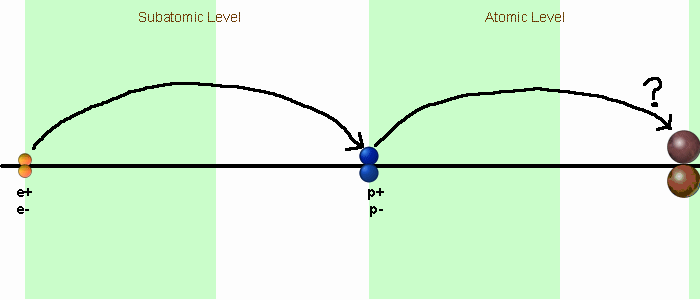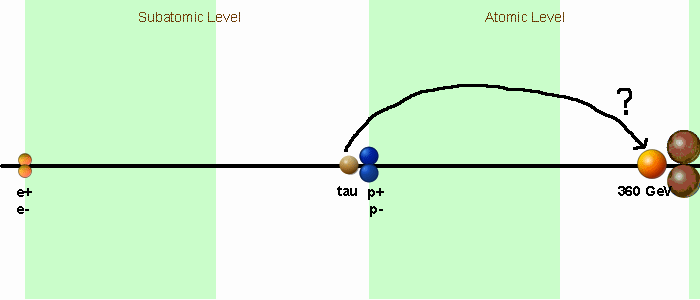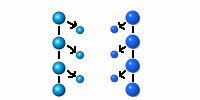|
On the other pages of this website I describe the granularity of the universe...I identify the points where an electron-positron pair and a proton-antiproton pair are created as being the key points of granularity, and I fill in the spaces around them by comparing the subatomic particles to the atomic ones. One of the pleasures of physics is that we are allowed to speculate on what we might find at higher or lower energy levels, based on what we see around us. To that end, I have a few speculations to make, and I make them now because I know that as soon as a proper physicist views this website he or she will instantly envision them as well. The vision involves particles that may or may not exist, and failure to find them, or if they are legitimately precluded from existing, in no way reflects on the rest of my theory. |
|||
|
|||
|
Speculation #1 |
|||
| Could there exist a new stable, electrically-charged particle-antiparticle pair, each with a mass near the mass of a lead nucleus? | |||
|
|||
| To put it in logical terms "The electron-positron pair is to the proton-antiproton pair as the proton-antiproton pair is to ...what?" | |||
|
Since both of the known points of granularity produce stable, electrically-charged particles, we would expect it to have those properties, as well, and we would expect it to be produced only in pair with its anti-matter twin. The reason it would have a mass near the mass of a lead nucleus is found in my comparison on other pages of the proton to a lead nucleus. And, of course, you could also wonder whether there were more points of granularity beyond even the third. |
Speculation #2 |
||
| Could there be a new particle with a mass just less than the mass of two lead nuclei? This speculation results in a mass very near twice the mass of the supposed top quark...coincidence? We'll see! | |||
|
|||
|
This would basically be the atomic equivalent of the subatomic tau particle. I began this entire theory by saying that the Omega minus was the heaviest strange baryon because the next step up was a proton-antiproton pair. Well, that was true as far as baryons go, but the tau particle also has just less than the mass of a proton-antiproton pair...in fact it's closer than the Omega. If we speculate that the existence of the tau particle is somehow correlated with that point of granularity (where the proton-antiproton energy is locked in as a particle-antiparticle pair) then it would be reasonable to wonder if there might be one at the next granularity level. Now, we don't know if the particle-antiparticle pair predicted in Speculation #1 exists, but we do know that the lead nucleus behaves like the proton, in that heavier nuclei decay to it and stop, even though less massive nuclei have essentially the same components. So, we could take the ratio of the tau mass divided by a proton mass and multiply that to a lead nucleus mass and POW!, the number that comes up is about 360 GeV, almost exactly twice the hypothetical top quark mass! Since I'm not a physicist, it's hard for me to tell the conditions that produced the evidence they claim for the top quark's existence. Often, though, there are conservation issues that result in two particles, so that even though the top quark mass is supposed to be 180 GeV, it could be that evidence for new particles actually showed up at 360 GeV. Just because I equate this particle to the tau particle doesn't mean that it would only emit neutrinos in its decay. It is up one level of granularity from the tau, so might emit other particles as well. |
|||
|
This would also be a good time to mention that there's obviously not a 1:1 relationship between the number of strange baryons and the number of atomic elements heavier than lead. Similarly, even though I said that the muon has three neutrinos and so compares to the 3He nucleus, that doesn't mean I need to add up the neutrinos of the tau particle to see what to compare it to. It's more qualitative. I think that the tau particle's proximity in mass to the proton-antiproton pair is more significant than how many neutrinos are emitted in its decay. That's why, when I mentally draw a line between the tau particle and something on the atomic level I don't just count up the same number of nucleons as the number of neutrinos the tau loses in its decay and connect to that element. |
Speculation #3 |
||
| Could there exist a baryonic form of neutrino? | |||
|
In logical terms: "The electron is to the neutrino as the proton is to ...what?" I'm going to guess that I'm far from the first one to make this speculation. Probably as soon as the first leptonic neutrino was identified they started wondering about that. Because my theory clearly shows the relationship between electrons and leptonic neutrinos (ie that the electron is a charged neutrino), maybe this will give them a clue as to how much energy would be required to produce a baryonic neutrino if it did exist. In fact, because the tau particle is linked to the second point of granularity in this theory, that is reason to suspect that any neutrino associated with the tau might be baryonic rather than leptonic. |
|||
|




